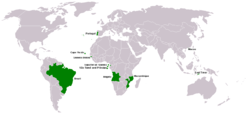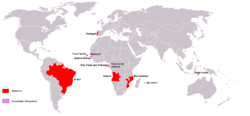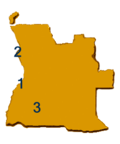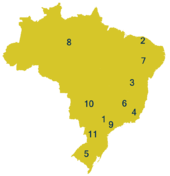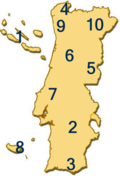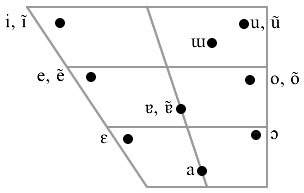Portuguese language
2008/9 Schools Wikipedia Selection. Related subjects: Languages
| Portuguese Português |
||
|---|---|---|
| Pronunciation: | [puɾtu'geʃ] (European), [portu'ges], [portu'geis] or [pohtu'geiʃ] (Brazilian) | |
| Spoken in: | Angola, Brazil, Cape Verde, East Timor, Guinea-Bissau, Chinese S.A.R. of Macau, Mozambique, Portugal, and São Tomé and Príncipe. | |
| Total speakers: | Native: 177 million (2005) | |
| Ranking: | 6 (native speakers) | |
| Language family: | Indo-European Italic Romance Italo-Western Western Gallo-Iberian Ibero-Romance West-Iberian Galician-Portuguese Portuguese |
|
| Writing system: | Latin alphabet ( Portuguese variant) | |
| Official status | ||
| Official language in: | 9 countries Community of Portuguese Language Countries |
|
| Regulated by: | International Portuguese Language Institute; CPLP; Academia Brasileira de Letras (Brazil) | |
| Language codes | ||
| ISO 639-1: | pt | |
| ISO 639-2: | por | |
| ISO 639-3: | por | |
| Note: This page may contain IPA phonetic symbols in Unicode. | ||
Portuguese ( português or língua portuguesa) is a Romance language that originated in what is now Galicia (Spain) and northern Portugal from the Latin spoken by romanized Pre-Roman peoples of the Iberian Peninsula (namely the Gallaeci, the Lusitanians, the Celtici and the Conii) about 2000 years ago. It spread worldwide in the 15th and 16th centuries as Portugal established a colonial and commercial empire (1415–1999) which spanned from Brazil in the Americas to Goa in India and Macau in China, in fact it was used exclusively on the island of Sri Lanka as the lingua franca for almost 350 years. During that time, many creole languages based on Portuguese also appeared around the world, especially in Africa, Asia, and the Caribbean.
Today it is one of the world's major languages, ranked 6th according to number of native speakers (approximately 177 million). It is the language with the largest number of speakers in South America, spoken by nearly all of Brazil's population, which amounts to over 51% of the continent's population even though it is the only Portuguese-speaking nation in the Americas. It is also a major lingua franca in Portugal's former colonial possessions in Africa. It is the official language of ten countries (see the table on the right), also being co-official with Spanish and French in Equatorial Guinea, with Cantonese Chinese in the Chinese special administrative region of Macau, and with Tetum in East Timor. There are sizable communities of Portuguese-speakers in various regions of North America, notably in the United States ( New Jersey, New England and south Florida) and in Ontario, Canada.
Spanish author Miguel de Cervantes once called Portuguese "the sweet language", while Brazilian writer Olavo Bilac poetically described it as a última flor do Lácio, inculta e bela: "the last flower of Latium, wild and beautiful".
Geographic distribution
Today, Portuguese is the official language of Angola, Brazil, Cape Verde, Guinea-Bissau, Portugal, São Tomé and Príncipe and Mozambique. It is also one of the official languages of Equatorial Guinea (with Spanish and French), the Chinese special administrative region of Macau (with Chinese), and East Timor, (with Tetum). It is a native language of most of the population in Portugal (100%), Brazil (100%), Angola (60%), and São Tomé and Príncipe (50%), and it is spoken by a plurality of the population of Mozambique (40%), though only 6.5% are native speakers. No data is available for Cape Verde, but almost all the population is bilingual, and the monolingual population speaks Cape Verdean Creole.
Small Portuguese-speaking communities subsist in former overseas colonies of Portugal such as Macau, where it is spoken as a first language by 0.6% of the population and East Timor.
Uruguay gave Portuguese an equal status to Spanish in its educational system at the north border with Brazil. In the rest of the country, it's taught as an obligatory subject beginning by the 6th grade.
It is also spoken by substantial immigrant communities, though not official, in Andorra, France, Luxembourg, Jersey (with a statistically significant Portuguese-speaking community of approximately 10,000 people), Paraguay, Namibia, South Africa, Switzerland, Venezuela and in the U.S. states of California, Connecticut, Florida, Massachusetts, New Jersey, New York and Rhode Island. In some parts of India, such as Goa and Daman and Diu Portuguese is still spoken. There are also significant populations of Portuguese speakers in Canada (mainly concentrated in and around Toronto) Bermuda and Netherlands Antilles.
Portuguese is an official language of several international organizations. The Community of Portuguese Language Countries (with the Portuguese acronym CPLP) consists of the eight independent countries that have Portuguese as an official language. It is also an official language of the European Union, Mercosul, the Organization of American States, the Organization of Ibero-American States, the Union of South American Nations, and the African Union (one of the working languages) and one of the official languages of other organizations. The Portuguese language is gaining popularity in Africa, Asia, and South America as a second language for study.
Portuguese and Spanish are the fastest-growing European languages, and, according to estimates by UNESCO, Portuguese is the language with the highest potential for growth as an international language in southern Africa and South America. The Portuguese-speaking African countries are expected to have a combined population of 83 million by 2050. Since 1991, when Brazil signed into the economic market of Mercosul with other South American nations, such as Argentina, Uruguay, and Paraguay, there has been an increase in interest in the study of Portuguese in those South American countries. The demographic weight of Brazil in the continent will continue to strengthen the presence of the language in the region. Although in the early 21st century, after Macau was ceded to China in 1999, the use of Portuguese was in decline in Asia, it is becoming a language of opportunity there; mostly because of East Timor's boost in the number of speakers in the last five years but also because of increased Chinese diplomatic and financial ties with Portuguese-speaking countries.
In July 2007, President Teodoro Obiang Nguema announced his government's decision to make Portuguese Equatorial Guinea's third official language, in order to meet the requirements to apply for full membership of the Community of Portuguese Language Countries. This upgrading from its current Associate Observer condition would result in Equatorial Guinea being able to access several professional and academic exchange programs and the facilitation of cross-border circulation of citizens. Its application is currently being assessed by other CPLP members.
In March 1994 the Bosque de Portugal (Portugal's Woods) was founded in the Brazilian city of Curitiba. The park houses the Portuguese Language Memorial, which honours the Portuguese immigrants and the countries that adopted the Portuguese language. Originally there were seven nations represented with pillars, but the independence of East Timor brought yet another pillar for that nation in 2007.
In March 2006, the Museum of the Portuguese Language, an interactive museum about the Portuguese language, was founded in São Paulo, Brazil, the city with the largest number of Portuguese speakers in the world.
Dialects
Portuguese is a pluricentric language with two main groups of dialects, those of Brazil and those of the Old World. For historical reasons, the dialects of Africa and Asia are generally closer to those of Portugal than the Brazilian dialects, although in some aspects of their phonetics, especially the pronunciation of unstressed vowels, they resemble Brazilian Portuguese more than European Portuguese. They have not been studied as widely as European and Brazilian Portuguese.
Audio samples of some dialects of Portuguese are available below. There are some differences between the areas but these are the best approximations possible. For example, the caipira dialect has some differences from the one of Minas Gerais, but in general it is very close. A good example of Brazilian Portuguese may be found in the capital city, Brasília, because of the generalized population from all parts of the country.
- Caipira — States of São Paulo (countryside; the city of São Paulo and the eastern areas of the state have their own dialect, called paulistano); southern Minas Gerais, northern Paraná, Goiás and Mato Grosso do Sul.
- Cearense — Ceará.
- Baiano — Bahia.
 Fluminense — Variants spoken in the states of Rio de Janeiro and Espírito Santo (excluding the city of Rio de Janeiro and its adjacent metropolitan areas, which have their own dialect, called carioca).
Fluminense — Variants spoken in the states of Rio de Janeiro and Espírito Santo (excluding the city of Rio de Janeiro and its adjacent metropolitan areas, which have their own dialect, called carioca).- Gaúcho — Rio Grande do Sul. (There are many distinct accents in Rio Grande do Sul, mainly due to the heavy influx of European immigrants of diverse origins, those which have settled several colonies throughout the state.)
- Mineiro — Minas Gerais (not prevalent in the Triângulo Mineiro, southern and southeastern Minas Gerais).
 Nordestino — northeastern states of Brazil ( Pernambuco and Rio Grande do Norte have a particular way of speaking).
Nordestino — northeastern states of Brazil ( Pernambuco and Rio Grande do Norte have a particular way of speaking).- Nortista — Amazon Basin states.
- Paulistano — Variants spoken around São Paulo city and the eastern areas of São Paulo state.
- Sertanejo — States of Goiás and Mato Grosso (the city of Cuiabá has a particular way of speaking).
- Sulista — Variants spoken in the areas between the northern regions of Rio Grande do Sul and southern regions of São Paulo state. (The cities of Curitiba, Florianópolis, and Itapetininga have fairly distinct accents as well.)
 Açoriano (Azorean) — Azores.
Açoriano (Azorean) — Azores. Alentejano — Alentejo
Alentejano — Alentejo Algarvio — Algarve (there is a particular dialect in a small part of western Algarve).
Algarvio — Algarve (there is a particular dialect in a small part of western Algarve). Alto-Minhoto — North of Braga (hinterland).
Alto-Minhoto — North of Braga (hinterland). Baixo-Beirão; Alto-Alentejano — Central Portugal (hinterland).
Baixo-Beirão; Alto-Alentejano — Central Portugal (hinterland). Beirão — Central Portugal.
Beirão — Central Portugal. Estremenho — Regions of Coimbra and Lisbon (the Lisbon dialect has some peculiar features not shared with the one of Coimbra).
Estremenho — Regions of Coimbra and Lisbon (the Lisbon dialect has some peculiar features not shared with the one of Coimbra). Madeirense (Madeiran) — Madeira.
Madeirense (Madeiran) — Madeira. Nortenho — Regions of Braga and Porto.
Nortenho — Regions of Braga and Porto. Transmontano — Trás-os-Montes e Alto Douro.
Transmontano — Trás-os-Montes e Alto Douro.
Other countries
- Cape Verde —
 Português cabo-verdiano ( Cape Verdean Portuguese)
Português cabo-verdiano ( Cape Verdean Portuguese) - Daman and Diu, India — Damaense.
- East Timor —
 Timorense ( East Timorese)
Timorense ( East Timorese) - Goa, India — Goês.
- Guinea-Bissau —
 Guineense ( Guinean Portuguese).
Guineense ( Guinean Portuguese). - Macau, China —
 Macaense ( Macanese)
Macaense ( Macanese) - Mozambique —
 Moçambicano ( Mozambican)
Moçambicano ( Mozambican) - São Tomé and Príncipe —
 Santomense
Santomense - Uruguay — Dialectos Portugueses del Uruguay (DPU).
Differences between dialects are mostly of accent and vocabulary, but between the Brazilian dialects and other dialects, especially in their most coloquial forms, there can also be some grammatical differences. The Portuguese-based creoles spoken in various parts of Africa, Asia, and the Americas are independent languages which should not be confused with Portuguese itself.
History
Arriving in the Iberian Peninsula in 216 BC, the Romans brought with them the Latin language, from which all Romance languages descend. The language was spread by arriving Roman soldiers, settlers and merchants, who built Roman cities mostly near the settlements of previous civilizations.
| Medieval Portuguese poetry |
|---|
| Das que vejo |
| nom desejo |
| outra senhor se vós nom, |
| e desejo |
| tam sobejo, |
| mataria um leon, |
| senhor do meu coraçom: |
| fim roseta, |
| bela sobre toda fror, |
| fim roseta, |
| nom me meta |
| em tal coita voss'amor! |
| João de Lobeira (c. 1270–1330) |
Between AD 409 and 711, as the Roman Empire collapsed in Western Europe, the Iberian Peninsula was conquered by Germanic peoples ( Migration Period). The occupiers, mainly Suebi and Visigoths, quickly adopted late Roman culture and the Vulgar Latin dialects of the peninsula. After the Moorish invasion of 711, Arabic became the administrative language in the conquered regions, but most of the population continued to speak a form of Romance commonly known as Mozarabic. The influence exerted by Arabic on the Romance dialects spoken in the Christian kingdoms of the north was small, affecting mainly their lexicon.
The earliest surviving records of a distinctively Portuguese language are administrative documents of the 9th century, still interspersed with many Latin phrases. Today this phase is known as Proto-Portuguese (between the 9th and the 12th centuries). In the first period of Old Portuguese — Galician-Portuguese Period (from the 12th to the 14th century) — the language gradually came into general use. For some time, it was the language of preference for lyric poetry in Christian Hispania, much like Occitan was the language of the poetry of the troubadours. Portugal was formally recognized as an independent kingdom by the Kingdom of Leon in 1143, with Afonso Henriques as king. In 1290, king Dinis created the first Portuguese university in Lisbon (the Estudos Gerais, later moved to Coimbra) and decreed that Portuguese, then simply called the "common language" should be known as the Portuguese language and used officially.
In the second period of Old Portuguese, from the 14th to the 16th century, with the Portuguese discoveries, the language was taken to many regions of Asia, Africa and the Americas (nowadays, the great majority of Portuguese speakers live in Brazil, in South America). By the 16th century it had become a lingua franca in Asia and Africa, used not only for colonial administration and trade but also for communication between local officials and Europeans of all nationalities. Its spread was helped by mixed marriages between Portuguese and local people, and by its association with Roman Catholic missionary efforts, which led to the formation of a creole language called Kristang in many parts of Asia (from the word cristão, "Christian"). The language continued to be popular in parts of Asia until the 19th century. Some Portuguese-speaking Christian communities in India, Sri Lanka, Malaysia, and Indonesia preserved their language even after they were isolated from Portugal.
The end of the Old Portuguese period was marked by the publication of the Cancioneiro Geral by Garcia de Resende, in 1516. The early times of Modern Portuguese, which spans from the 16th century to present day, were characterized by an increase in the number of learned words borrowed from Classical Latin and Classical Greek since the Renaissance, which greatly enriched the lexicon.
Characterization
A distinctive feature of Portuguese is that it preserved the stressed vowels of Vulgar Latin, which became diphthongs in other Romance languages; cf. Fr. pierre, Sp. piedra, It. pietra, Port. pedra, from Lat. petra; or Sp. fuego, It. fuoco, Port. fogo, from Lat. focum. Another characteristic of early Portuguese was the loss of intervocalic l and n, sometimes followed by the merger of the two surrounding vowels, or by the insertion of an epenthetic vowel between them: cf. Lat. salire, tenere, catena, Sp. salir, tener, cadena, Port. sair, ter, cadeia.
When the elided consonant was n, it often nasalized the preceding vowel: cf. Lat. manum, rana, bonum, Port. mão, rãa, bõo (now mão, rã, bom). This process was the source of most of the nasal diphthongs which are typical of Portuguese. In particular, the Latin endings -anem, -anum and -onem became -ão in most cases, cf. Lat. canem, germanum, rationem with Modern Port. cão, irmão, razão, and their plurals -anes, -anos, -ones normally became -ães, -ãos, -ões, cf. cães, irmãos, razões.
Movement to make Portuguese an official language at the UN
There is a growing number of people in the Portuguese speaking media and the internet who are presenting the case to the CPLP and other organizations to run a debate in the Lusophone community with the purpose of bringing forward a petition to make Portuguese an official language at the United Nations.
In October 2005, during the international Convention of the Elos Club International that took place in Tavira, Portugal a petition was written and unanimously approved whose text can be found on the internet with the title Petição Para Tornar Oficial o Idioma Português na ONU.
Romulo Alexandre Soares, president of the Brazil-Portugal Chamber highlights that the positioning of Brazil in the international arena as one of the emergent powers of the 21 century, the size of its population, and the presence of the language around the world provides legitimacy and justifies a petition to the UN to make the Portuguese an official language at the UN.
Vocabulary
Most of the lexicon of Portuguese is derived from Latin. Nevertheless, because of the Moorish occupation of the Iberian Peninsula during the Middle Ages, and the participation of Portugal in the Age of Discovery, it has adopted loanwords from all over the world.
Very few Portuguese words can be traced to the pre-Roman inhabitants of Portugal, which included the Gallaeci, Lusitanians, Celtici and Cynetes. The Phoenicians and Carthaginians, briefly present, also left some scarce traces. Some notable examples are abóbora "pumpkin" and bezerro "year-old calf", from the nearby Celtiberian language (probably through the Celtici); cerveja "beer", from Celtic; saco "bag", from Phoenician; and cachorro "dog, puppy", from Basque.
In the 5th century, the Iberian Peninsula (the Roman Hispania) was conquered by the Germanic Suevi and Visigoths. As they adopted the Roman civilization and language, however, these people contributed only a few words to the lexicon, mostly related to warfare — such as espora "spur", estaca "stake", and guerra "war", from Gothic *spaúra, *stakka, and *wirro, respectively.
Between the 9th and 15th centuries Portuguese acquired about 1000 words from Arabic by influence of Moorish Iberia. They are often recognizable by the initial Arabic article a(l)-, and include many common words such as aldeia "village" from الضيعة aldaya, alface "lettuce" from الخس alkhass, armazém "warehouse" from المخزن almahazan, and azeite "olive oil" from زيت azzait. From Arabic came also the grammatically peculiar word oxalá "hopefully". The Mozambican currency name metical was derived from the word مطقال miṭqāl, a unit of weight. The word Mozambique itself is from the Arabic name of sultan Muça Alebique (Musa Alibiki). The name of the Portuguese town of Fátima comes from the name of one of the daughters of the prophet Muhammad.
Starting in the 15th century, the Portuguese maritime explorations led to the introduction of many loanwords from Asian languages. For instance, catana "cutlass" from Japanese katana; corja "rabble" from Malay kórchchu; and chá "tea" from Chinese chá.
From South America came batata "potato", from Taino; ananás and abacaxi, from Tupi-Guarani naná and Tupi ibá cati, respectively (two species of pineapple), and tucano " toucan" from Guarani tucan. See List of Brazil state name etymologies, for some more examples.
From the 16th to the 19th century, the role of Portugal as intermediary in the Atlantic slave trade, with the establishment of large Portuguese colonies in Angola, Mozambique, and Brazil, Portuguese got several words of African and Amerind origin, especially names for most of the animals and plants found in those territories. While those terms are mostly used in the former colonies, many became current in European Portuguese as well. From Kimbundu, for example, came kifumate → cafuné "head caress", kusula → caçula "youngest child", marimbondo "tropical wasp", and kubungula → bungular "to dance like a wizard".
Finally, it has received a steady influx of loanwords from other European languages. For example, melena "hair lock", fiambre "wet-cured ham" (in contrast with presunto "dry-cured ham" from Latin prae-exsuctus "dehydrated"), and castelhano "Castilian", from Spanish; colchete/crochê "bracket"/"crochet", paletó "jacket", batom "lipstick", and filé/filete "steak"/"slice" respectively, from French crochet, paletot, bâton, filet; macarrão "pasta", piloto "pilot", carroça "carriage", and barraca "barrack", from Italian maccherone, pilota, carrozza, baracca; and bife "steak", futebol, revólver, estoque, folclore, from English beef, football, revolver, stock, folklore.
Classification and related languages
Portuguese belongs to the West Iberian branch of the Romance languages, and it has special ties with the following members of this group:
- Galician and the Fala, its closest relatives. See below.
- Spanish, the major language closest to Portuguese. (See also Differences between Spanish and Portuguese.)
- Mirandese, another West Iberian language spoken in Portugal.
- Judeo-Portuguese and Judeo-Spanish, languages spoken by Sephardic Jews, which remained close to Portuguese and Spanish.
Despite the obvious lexical and grammatical similarities between Portuguese and other Romance languages, it is not mutually intelligible with most of them. Apart from Galician, Portuguese speakers will usually need some formal study of basic grammar and vocabulary, before attaining a reasonable level of comprehension of those languages, and vice-versa.
Galician and the Fala
The closest language to Portuguese is Galician, spoken in the autonomous community of Galicia (northwestern Spain). The two were at one time a single language, known today as Galician-Portuguese, but since the political separation of Portugal from Galicia they have diverged somewhat, especially in pronunciation and vocabulary. Nevertheless, the core vocabulary and grammar of Galician are still noticeably closer to Portuguese than to Spanish. In particular, like Portuguese, it uses the future subjunctive, the personal infinitive, and the synthetic pluperfect (see the section on the grammar of Portuguese, below). Mutual intelligibility (estimated at 85% by R. A. Hall, Jr., 1989) is good between Galicians and northern Portuguese, but poorer between Galicians and speakers from central Portugal.
The Fala language is another descendant of Galician-Portuguese, spoken by a small number of people in the Spanish towns of Valverdi du Fresnu, As Ellas and Sa Martín de Trebellu (autonomous community of Extremadura, near the border with Portugal).
Influence on other languages
Many languages have borrowed words from Portuguese, such as Indonesian, Sri Lankan Tamil and Sinhalese (see Sri Lanka Indo-Portuguese), Malay, Bengali, English, Hindi, Konkani, Marathi, Tetum, Xitsonga, Papiamentu, Japanese, Bajan Creole (Spoken in Barbados), Lanc-Patuá (spoken in northern Brazil) and Sranan Tongo (spoken in Suriname). It left a strong influence on the língua brasílica, a Tupi-Guarani language which was the most widely spoken in Brazil until the 18th century, and on the language spoken around Sikka in Flores Island, Indonesia. In nearby Larantuka, Portuguese is used for prayers in Holy Week rituals. The Japanese-Portuguese dictionary Nippo Jisho (1603) was the first dictionary of Japanese in a European language, a product of Jesuit missionary activity in Japan. Building on the work of earlier Portuguese missionaries, the Dictionarium Anamiticum, Lusitanum et Latinum (Annamite-Portuguese-Latin dictionary) of Alexandre de Rhodes (1651) introduced the modern orthography of Vietnamese, which is based on the orthography of 17th-century Portuguese. The Romanization of Chinese was also influenced by the Portuguese language (among others), particularly regarding Chinese surnames; one example is Mei.
See also List of English words of Portuguese origin, Loan words in Indonesian, Japanese words of Portuguese origin, Borrowed words in Malay, Sinhala words of Portuguese origin, Loan words from Portuguese in Sri Lankan Tamil.
Derived languages
Beginning in the 16th century, the extensive contacts between Portuguese travelers and settlers, African slaves, and local populations led to the appearance of many pidgins with varying amounts of Portuguese influence. As these pidgins became the mother tongue of succeeding generations, they evolved into fully fledged creole languages, which remained in use in many parts of Asia and Africa until the 18th century. Some Portuguese-based or Portuguese-influenced creoles are still spoken today, by over 3 million people worldwide, especially people of partial Portuguese ancestry.
Phonology
There is a maximum of 9 oral vowels and 19 consonants, though some varieties of the language have fewer phonemes (Brazilian Portuguese has only 8 oral vowel phones). There are also five nasal vowels, which some linguists regard as allophones of the oral vowels, ten oral diphthongs, and five nasal diphthongs.
Vowels
To the seven vowels of Vulgar Latin, European Portuguese has added two near central vowels, one of which tends to be elided in rapid speech, like the e caduc of French (represented either as /ɯ̽/, or /ɨ/, or /ə/). The high vowels /e o/ and the low vowels /ɛ ɔ/ are four distinct phonemes, and they alternate in various forms of apophony. Like Catalan, Portuguese uses vowel quality to contrast stressed syllables with unstressed syllables: isolated vowels tend to be raised, and in some cases centralized, when unstressed. Nasal diphthongs occur mostly at the end of words.
Consonants
| Bilabial | Labio- dental |
Dental | Alveolar | Post- alveolar |
Palatal | Velar | Uvular | |||||||||
|---|---|---|---|---|---|---|---|---|---|---|---|---|---|---|---|---|
| Plosives | p | b | t̪ | d̪ | k | g | ||||||||||
| Nasals | m | n | ɲ | |||||||||||||
| Fricatives | f | v | s | z | ʃ | ʒ | ʁ | |||||||||
| Laterals | l | ʎ | ||||||||||||||
| Flaps | ɾ | |||||||||||||||
The consonant inventory of Portuguese is fairly conservative. The medieval affricates /ts/, /dz/, /tʃ/, /dʒ/ merged with the fricatives /s/, /z/, /ʃ/, /ʒ/, respectively, but not with each other, and there were no other significant changes to the consonant phonemes since then. However, some remarkable dialectal variants and allophones have appeared, among which:
- In many regions of Brazil, /t/ and /d/ have the affricate allophones [tʃ] and [dʒ], respectively, before /i/ and /ĩ/. ( Quebec French has a similar phenomenon, with alveolar affricates instead of postalveolars. Japanese is another example).
- At the end of a syllable, the phoneme /l/ has the allophone [u̯] in Brazilian Portuguese ( L-vocalization).
- In many parts of Brazil and Angola, intervocalic /ɲ/ is pronounced as a nasalized palatal approximant [j̃] which nasalizes the preceding vowel, so that for instance /ˈniɲu/ is pronounced [ˈnĩj̃u].
- In most of Brazil, the alveolar sibilants /s/ and /z/ occur in complementary distribution at the end of syllables, depending on whether the consonant that follows is voiceless or voiced, as in English. But in most of Portugal and parts of Brazil sibilants are postalveolar at the end of syllables, /ʃ/ before voiceless consonants, and /ʒ/ before voiced consonants (in Judeo-Spanish, /s/ is often replaced with /ʃ/ at the end of syllables, too).
- There is considerable dialectal variation in the value of the rhotic phoneme /ʁ/. See Guttural R in Portuguese, for details.
Grammar
A particularly interesting aspect of the grammar of Portuguese is the verb. Morphologically, more verbal inflections from classical Latin have been preserved by Portuguese than any other major Romance language. See Romance copula, for a detailed comparison. It has also some innovations not found in other Romance languages (except Galician and the Fala):
- The present perfect tense has an iterative sense unique among the Romance languages. It denotes an action or a series of actions which began in the past and are expected to keep repeating in the future. For instance, the sentence Tenho tentado falar com ela would be translated to "I have been trying to talk to her", not "I have tried to talk to her". On the other hand, the correct translation of the question "Have you heard the latest news?" is not *Tem ouvido a última notícia?, but Ouviu a última notícia?, since no repetition is implied.
- The future subjunctive tense, which was developed by medieval West Iberian Romance, but has now fallen into disuse in Spanish, is still used in vernacular Portuguese. It appears in dependent clauses that denote a condition which must be fulfilled in the future, so that the independent clause will occur. Other languages normally employ the present tense under the same circumstances:
- Se for eleito presidente, mudarei a lei.
- If I am elected president, I will change the law.
- Quando fores mais velho, vais entender.
- When you are older, you will understand.
- The personal infinitive: infinitives can inflect according to their subject in person and number, often showing who is expected to perform a certain action; cf. É melhor voltares "It is better [for you] to go back," É melhor voltarmos "It is better [for us] to go back." Perhaps for this reason, infinitive clauses replace subjunctive clauses more often in Portuguese than in other Romance languages.
Writing system
| Portugal/Africa/Asia | Brazil | translation |
|---|---|---|
| anónimo | anônimo | anonymous |
| facto | fato | fact |
| ideia | idéia | idea |
| direcção | direção | direction |
| óptimo | ótimo | great |
| frequente | freqüente | frequent |
| voo | vôo | flight |
Portuguese is written with the Latin alphabet, making use of five diacritics to denote stress, vowel height, contraction, nasalization, and other sound changes (acute accent, grave accent, circumflex accent, tilde, and cedilla). Brazilian Portuguese also uses the diaeresis mark. Accented characters and digraphs are not counted as separate letters for collation purposes.
Brazilian vs. European spelling
There are some minor differences between the orthographies of Brazil and other Portuguese language countries. One of the most pervasive is the use of acute accents in the European/African/Asian orthography in many words such as sinónimo, where the Brazilian orthography has a circumflex accent, sinônimo. Another important difference is that Brazilian spelling often lacks c or p before c, ç, or t, where the European orthography has them; for example, cf. Brazilian fato with European facto, "fact", or Brazilian objeto with European objecto, "object". Some of these spelling differences reflect differences in the pronunciation of the words, but others are merely graphic.
Examples
- Excerpt from the Portuguese national epic Os Lusíadas, by author Luís de Camões (I, 33)
| Original | IPA (European Portuguese) | IPA (Brazilian Portuguese) | Translation |
|---|---|---|---|
| Sustentava contra ele Vénus bela, | suʃtẽˈtavɐ ˈkõtɾɐ ˈeɫɨ ˈvɛnuʒ ˈbɛɫɐ | sustẽˈtavɐ ˈkõtɾɐ ˈeli ˈvẽnuz ˈbɛlɐ | Against him spoke the lovely Venus |
| Afeiçoada à gente Lusitana, | ɐfɐi̯swˈada ˈʒẽtɨ ɫuziˈtɐnɐ | afei̯soˈada ˈʒẽtʃi luziˈtɐ̃nɐ | Favoring the people of Portugal, |
| Por quantas qualidades via nela | puɾ ˈkwɐ̃tɐʃ kwɐɫiˈdadɨʒ ˈviɐ ˈnɛɫɐ | poɾ ˈkwɐ̃tɐs kwaliˈdadʒiz ˈviɐ ˈnɛlɐ | For her love of Roman virtue |
| Da antiga tão amada sua Romana; | dãˈtigɐ tɐ̃ũ ̯ ɐˈmadɐ ˈsuɐ ʁuˈmɐnɐ | dãˈtʃigɐ tɐ̃ũ ̯ aˈmadɐ ˈsuɐ xõˈmɐ̃nɐ | She saw resurrected in them; |
| Nos fortes corações, na grande estrela, |
nuʃ ˈfɔɾtɨʃ kuɾɐˈsõĩ ̯ʒ nɐ ˈgɾɐ̃dɨʃˈtɾeɫɐ |
nus ˈfɔɾtʃis koɾaˈsõĩ ̯z na ˈgɾɐ̃dʒj esˈtɾelɐ |
In their stout hearts, in the star |
| Que mostraram na terra Tingitana, | kɨ muʃˈtɾaɾɐ̃ũ ̯ nɐ ˈtɛʁɐ tĩʒiˈtɐnɐ | ki mosˈtɾaɾɐ̃ũ ̯ na ˈtɛxɐ tʃĩʒiˈtɐ̃nɐ | Which shone bright above Ceuta, |
| E na língua, na qual quando imagina, | i nɐ ˈɫĩgwɐ nɐ kwaɫ ˈkwɐ̃dw imɐˈʒinɐ | i na ˈlĩgwɐ na kwau̯ ˈkwɐ̃dw imaˈʒĩnɐ | In the language which an inventive mind |
| Com pouca corrupção crê que é a Latina. | kõ ˈpokɐ kuʁupˈsɐ̃ũ ̯ kɾe kjɛ ɐ ɫɐˈtinɐ | kõ ˈpou̯kɐ koxupiˈsɐ̃ũ ̯ kɾe kjɛ a laˈtʃĩnɐ | Could mistake for Latin, passably declined. |
